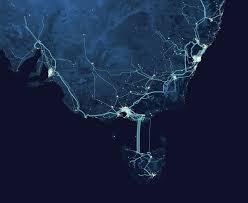
If you’re fossicking through the Marinus Whole of State Business Case (WoSBC) to find a collective tick of approval for the project , don’t bother.
It’s not there.
Everywhere there are warning signs, interspersed with a few assertions of benefits most of which are hidden by the censor’s black marker pen.
Yet the Premier, his Ministers and minders have told us that whatever good deal was outlined in the April 2025 WoSBC they managed to turn it into a fantastic deal, a not-to-be-missed opportunity of a lifetime, thanks to their commitment to the task, to negotiate a better arrangement with the Feds during the caretaker period of government.
It’s not obvious from the WoSBC how the extra from the Feds have helped offset any of the doubts clearly set out in the WoSBC.
Transmission costs will rise. Of that there is no doubt, With our share of Marinus costs, plus fees for a now regulated Basslink and the huge North West Transmission Development (NWTD) , which together will be more than the existing transmission network, transmission costs, will experience a sharp rise.
Will TasNetworks become a money spinner able to compensate the governments with higher returns?
Unfortunately not.
The WoSBC addresses that question:
“NWTD Stage 1 has numerous funding issues to be resolved. Under current arrangements, for the first two thirds of its asset life, the project does not receive enough revenue to fulfill its debt obligations and other expenses.”
So, there’s little doubt about the transmission side. Higher fees and lower returns for TasNetworks. The exec summary summed it up for doubters:
“Transmission prices will be lower without Marinus Link, saving typical residential customers an estimated $70 compared to Marinus Link Stage 1. MI (My note: MI means Major Industrials) customers will face less financial pressure, with an estimated $20 million in additional transmission costs no longer applying to that sector.”
I went searching for an explanation for the increased Hydro returns but it proved to be more elusive than the thylacine, even harder to track down than the government’s fabled budget surplus. Every doorway was barricaded with black marker pen.
So I was forced to skip Chapter 8 Financial Impacts on Government businesses, hoping to find solace and meaning in Chapter 9 Impact on Government finances and credit rating.
At least we might get to understand how future returns from Hydro will feed back into the general government and fund all the alleged benefits, from offsetting transmission costs for a start, secondly helping to stabilise government debt as described in the publicly available WoSBC, and thirdly providing a boost to own source revenue to enable a resumption of adequate funding of much needed services.
That was stupid of me.
No where can a reader understand how the benefits are planned to flow through the system.
Instead we get a series of partial analyses but with no overall reconciliation of benefits,
I guess that was too much to expect of the biggest infrastructure project in the State’s history that will put us on a path, whether we like it or not, for the next 50 years.
A rocky path I’d say.
To illustrate what I mean let’s have a closer look at what we were told about government debt. Specifically, the debt for the general government and its trading businesses (called the Total Non-Financial Public Sector or TNFPS)
In a world first for modelling, a “lock and shock” approach has been adopted. It’s a world first because even our friend Google is yet to learn of the approach.
When looking at future debt, existing government debt was “locked” at current levels. Or at least the low-ball estimates from the 24/25 Revised Estimate Report released in February 2025, which we now know to be not only hopelessly out of date, but seriously flawed because of the wilful omission by Treasurer Guy Barnett of at least $1 billion in health spending from the Forward Estimates, and which didn’t include unfunded superannuation which is a de facto borrowing in anyone’s lexicon.
The “locked” existing debt level was the baseline debt level to which was added the “shock” of more debt to fund Hydro and Tas Network’s Marinus developments, all of which will need to be debt funded.
Our crippling existing debt was cast aside whilst Marinus was considered. The WoSBC acknowledged this ridiculous scenario with the droll comment:
“ … in this regard, it could be implied the baseline projections are optimistic…”
Optimistic? Or deliberately drawing attention to the pointless conclusion being drawn?
Don’t worry folks it’s “… only intended to provide a high-level overview and should not be considered a comprehensive set of full financials…..”
Here we were contemplating….. or at least some contemplated whilst most or us were kept in the dark…….by far the largest infrastructure project in the State’s history … and the government tried, but not near hard enough, to provide a more comprehensive look at the broader picture.
It’s important not to forget about the growing existing debt, as how can we possibly know how much of the new windfall gains from Hydro will simply be swallowed up by servicing the alarming (and increasing?) level of existing debt. I am sure the credit rating agencies are watching.
The WoSBC exec summary comments as follows:
“When General Government Sector (GGS) net debt is combined with PNFC Sector net debt, Total Non-Financial Public Sector (TNFPS) net debt is modelled to peak at nearly $19 billion in 2031-32, assuming both projects and Hydro’s major projects are progressed. This estimate assumes a balanced GGS fiscal position is achieved quickly and contrasts with the average annual level of TNFPS net debt over the past 15 years of approximately $2.6 billion.” [Emphasis added].
It should be noted that the revised projections in the aborted 25/26 budget plus unfunded super together increase the debt from $19 billion to $30 billion and if it continues to grow, there goes all the windfall gains. Whoosh. There’ll be nothing left to fund extra services.
The crux of our current problems is that increasing debt servicing costs is taking an increasing share of revenues leaving less in real terms to fund government services. Marinus is presented as a new revenue source.
Increased revenues were presented in isolation, not in the context of what overall government revenues are likely to be and how new revenue assists to fill the increasing void. We were given no hint of Marinus inspired revenue in the context of our other revenues. A chart showing 20 years of projected revenues from Marinus is presented but in nominal $ terms which obviously grows over time due to inflation.
We need to see revenues in real terms in the context of our other revenue for it to have any meaning. Without it it’s just PR hype. Revenue here includes not just the Marinus associated revenues earned by Hydro, but the smaller expected revenue streams from our equity stake in Marinus which is likely to decline if we are unable to keep making equity contribution that will almost certainly result due to likely cost blow outs. The report then gave a tongue -in-cheek explanation and chart showing how inflation makes nominal returns over long time frames appear unexpectedly high ….. a so-called “sticker shock effect” which I took to be a warning about future returns because they’re all overstated because they haven’t been adjusted to exclude inflation.
To say as Minister Duigan did when speaking to Leon Compton on ABC Hobart Radio on Friday 1st August that Hydro return to government will be on average $470 million per annum, neglects to say that it’s based on nominal figures, unadjusted for inflation, over a 20 year period. In real terms this will be considerably less. To convey the impression to listeners than we will be better off by $470 million every year in today’s $ terms is deliberately misleading.
Even if it were true, it would only be a drop in the ocean given our current problems. Let’s not get too carried away at this stage. The Pre Election Financial Outlook (PEFO) Report, let’s not forget, identified the current gap between revenues and outlays, the current borrowing requirement in the general government sector, as $2.7 billion, so $470 million adjusted for 20 years of inflation may contribute perhaps 10 per cent.
But there are risks.
Let’s not forget that increased connectivity, by its very nature, means the arbitrage advantages that may exist across a network at one point in time, and which prompts increased connectivity, will gradually disappear because of that increased connectivity. A large costly interconnector contains the seeds of its own eventual non-viability.
The WoSBC affirms it’s “a point in time” view of the world, which is code for saying we can’t predict the future. The exec summary spells it out for sceptics:
“The Government should exercise caution in “locking in” expenditure based on modelled Hydro Tasmania returns.”
There are also credit ratings issues:
“The modelled level of TNFPS net debt is expected to put near term pressure on the State’s credit rating, which will be exacerbated if the results from Hydro Tasmania do not materialise as expected or a return to a GGS fiscal balance is achieved more slowly.”
Which means if the Liberal’s fiscal surplus is not just around the next corner as they keep telling us, proceeding with Marinus may cause interest rates on all government debt to rise, further squeezing what’s available to fund services.
One relentless feature of all major projects is that costs keep rising and the benefits are slower to appear. In the case of costs, the situation is likely to be worse for Marinus as the exec summary points out:
“Approximately 55 per cent of the project cost is yet to be validated and refined for final submission to the Australian Energy Regulator (AER). If approved by the AER, any cost increases will be met by customers”
Even if benefits do ensue, the benefits suggested by an “average’ over the life of a project is rarely achieved in the early years, meaning more debt is needed to fill the gap early on and the higher debt can’t be constrained especially if you’re approaching a point of no return which Tasmania is.
Hydro is planning to develop Tarraleah as part of its contribution to more on-island generation and this will all require borrowed funds. But as the WoSBC points out:
“Additional renewables are important to maximise Hydro’s trading opportunities. However, in practice, new renewables projects will still need to achieve environmental and planning approvals and achieve the necessary commercial viability.”
In the past, half the revenue earned from windfarms has been from RECs (Renewable Energy Certificates) with the other half from the electricity itself. RECs no longer apply to new renewables. In the absence of RECs will proponents still build without an off take/power purchase agreement.
If ‘unlikely’ is the answer does that mean an off-take/power purchase agreement with Hydro?
Does this mean that not only will the public pay to fund Marinus and consumers will pay to service its debts, Hydro will also have to shoulder more risks to allow extra generation facilities to be built to justify the building of Marinus, so those new entrants can make a 15 per cent guaranteed return on their investments. This leaves Hydro likely hoping for continued arbitrage advantages to enable windfall profits from exporting, profits which have been conspicuously absent from Hydro’s recent past except for rare occurrences, even when above average rainfall have filled its dams?
Are we really going to be better off?

